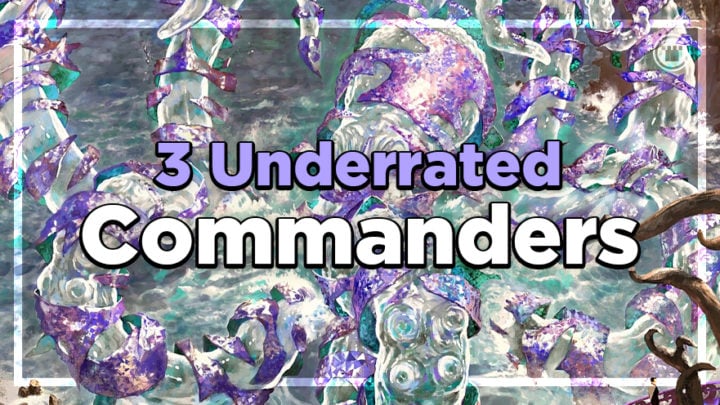Every commander is unique, and no two decks are alike. However, some legendary creatures see a lot more play than others; these are usually the face commanders of preconstructed decks, or the more obviously powerful choices in a particular archetype. When these decks make up a lot of the collective pool in Commander, some of the more interesting commanders don’t always receive the love or attention they deserve.
I’ll bring you through three decks today, each of which is piloted by more obscure commanders that highlight unique aspects to their colors. They all required a little more work to build than the average deck, but the reward of a truly incredible play experience is well worth the time.
I have built all three decks to be under $100 in budget; this is the sweet spot between power and affordability to me, giving you the highest power-to-dollar ratio. They can all be upgraded to include more powerful or pricey cards, but they’re currently built to fit in comfortably at any mid-powered table.
Laelia, the Blade Reforged – Exile Voltron
Mono-red decks are usually known for the amount of damage they can deal, or the number of Goblins they create. While these are both fantastic ways to play, red can sometimes feel like it’s a little lacking in diversity. Laelia, the Blade Reforged is one commander that has flown under the radar since her debut in the Strixhaven preconstructed deck, Lorehold Legacies. At first glance, she appears to be more of a supporting character: repeatable value that can become a threat over time. I’m sure a lot of players haven’t even considered what a deck with her in the command zone would look like, and I wouldn’t blame them; “exile matters” is hardly a theme that conjures up an immediate list of staples to get started with!
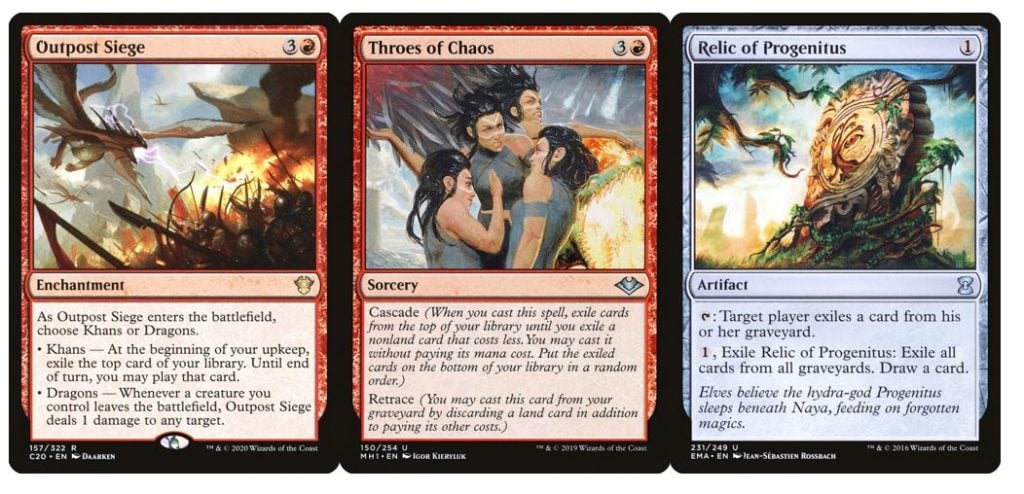
The goal of this deck is to use Laelia as your main offensive while continuously exiling cards from your library and graveyard for value. Cards like Outpost Siege give you an extra card every turn while also growing your commander; when you have multiple effects like this, you can end up matching Simic decks in card advantage, albeit in a unique way. Cascade also triggers Laelia’s growth ability, so cards like Throes of Chaos are ideal to keep the gas flowing and prevent flooding. You can also run a lot of graveyard hate, as it pulls double duty here: Relic of Progenitus can be used to exile a card every turn to pump Laelia, or can be used to shut down graveyard-heavy decks.
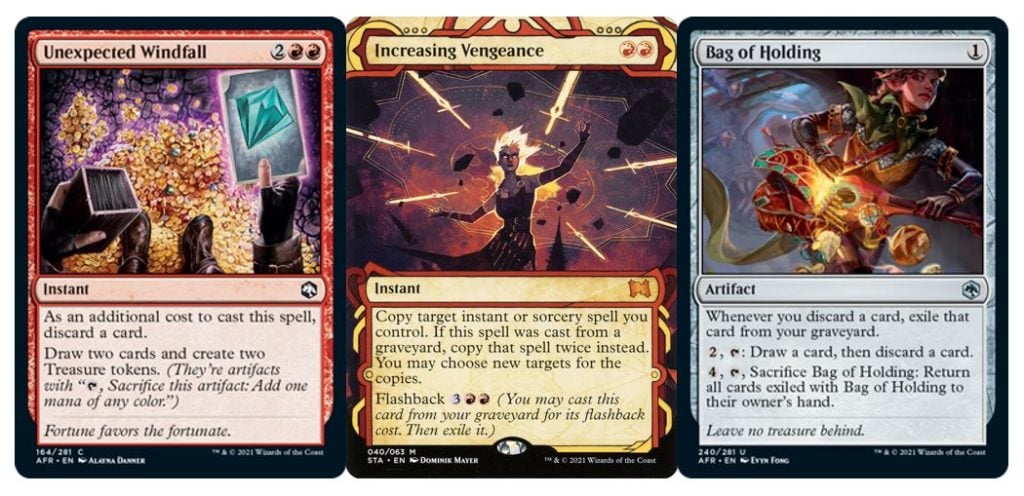
One of the main ways that red decks accrue value is through cards like Unexpected Windfall. They work in conjunction with flashback spells like Increasing Vengeance to mitigate the discard effect. It’s best to think of this deck as one that spreads your hand across several zones, rather than keeping them all in your grip. I think deck building in red can be overhauled to place greater emphasis on this approach; as this deck will show you, you rarely ever run out of options or things to do. You make extensive use of the graveyard as a secondary value engine, with a number of cards that utilize abilities like flashback, encore, or escape to keep you flush with options. Bag of Holding is particularly effective here: every card you discard gets exiled and grows Laelia, all while building you a fresh new hand for when you need it.
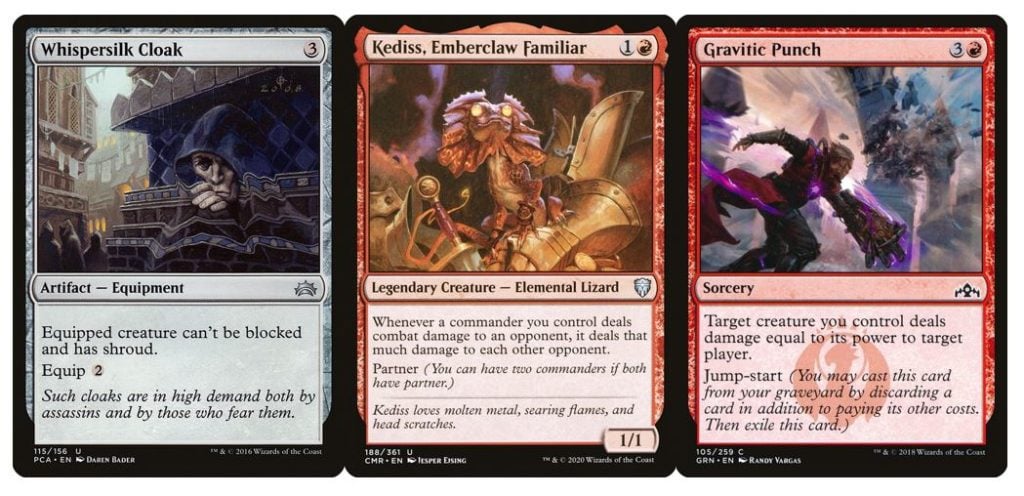
While this is an extremely value-oriented deck, it’s still a Voltron strategy at heart. The main win condition is Laelia herself, though her lack of evasion can prove difficult when it comes to punching through blockers. Whispersilk Cloak is the perfect Equipment to turn Laelia into an unstoppable assassin, and Kediss, Emberclaw Familiar effectively triples your damage output. Gravitic Punch is exceptional in this deck: it’s a win condition you can discard for later use, it’s a discard enabler, and it even exiles itself to jump-start to further grow Laelia! Even if all of these methods prove unsuccessful, you’ll be generating continuous value and amassing a board of creatures, so you’ll never fall behind.
Check out the full decklist here!
Laelia, the Blade Reforged is terrifying. She may be obscure, but she is proof that red is capable of so much more than direct damage and angry creatures. If you like the idea of gaining value in unconventional ways — while applying excessive pressure — then look no further than this powerful Spirit!
Octavia, Living Thesis – Spellslinger Beatdown
Okay, hear me out on this one. Spellslinger is nothing unique, I know, but this approach with Octavia, Living Thesis is one of a kind. Octavia is your late game: you deploy her after you’ve built up a small board of creatures and stocked your graveyard. She then supersizes a creature with every spell cast, giving you a lethal army in no time! Her ability can even be used on opponents’ creatures; you can use this to your advantage to garner favor, or to cause blowouts in combat. Her innate protection is also invaluable; “ward 8” is so strong that it’s essentially hexproof. Swords to Plowshares seems extremely inefficient at nine mana, so it’s often sent elsewhere. Octavia’s ward ability frees up resources that would otherwise be dedicated to protecting your engine, allowing you to keep your foot to the floor.
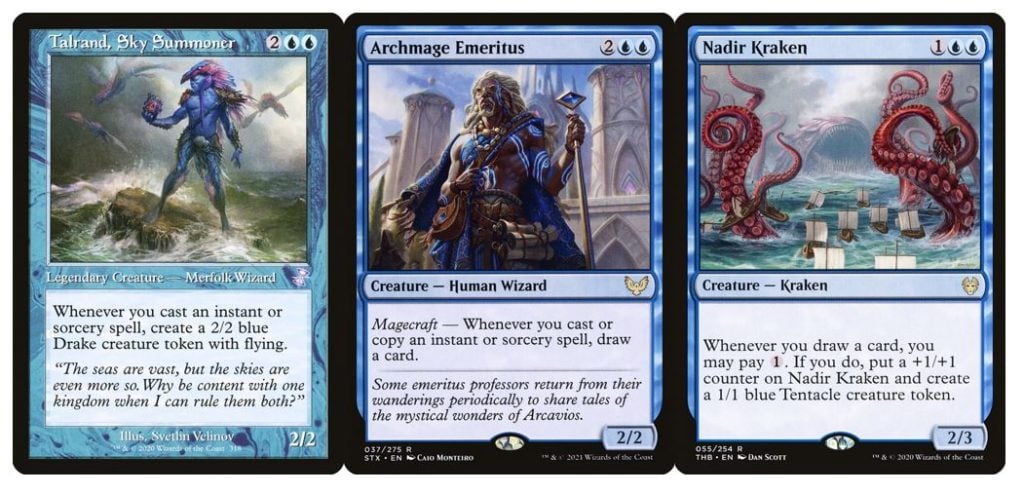
The core plan of any Spellslinger deck is to use permanents that reward you for playing multiple spells in a turn, so naturally Talrand, Sky Summoner is an automatic inclusion. Archmage Emeritus greatly increases your card velocity, often drawing you several cards a turn. The deck is packed to the brim with cantrips and card draw spells, so Nadir Kraken quickly gets out of hand as both a token generator and potent threat.
Every one of these effects is powerful by itself, but they become truly frightening in concert with one another. When used in conjunction with what I call Octavia’s “octification” ability, suddenly every token becomes a must-answer threat; your opponents could just try to remove Octavia to ease the pressure, but it still comes at an extremely steep cost!
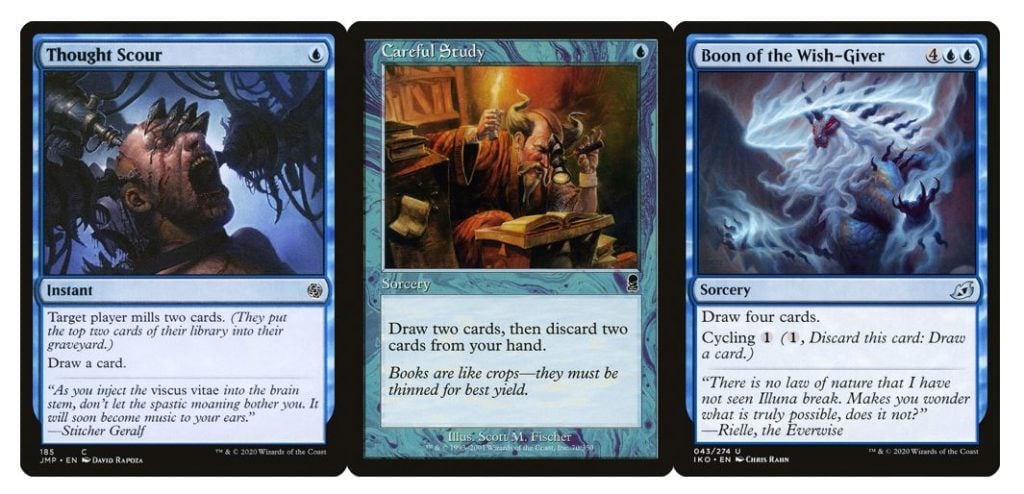
In order to generate tokens and turn them into real threats, you need cheap spells. Cantrips are particularly efficient; they’re cheap and replaceable, especially the likes of Thought Scour, whose mill can help power Octavia out ahead of schedule. Cards like Careful Study are also a fantastic choice to keep the spells flowing, and the discard can be easily mitigated through the use of flashback spells like Think Twice or Deep Analysis. Cycling can be a useful ability, too, as it gives you spells that can be binned early on or cast for their full value later in the game. Boon of the Wish-Giver is a perfect example: it’s likely to be cycled early to help advance your game plan, but it’s an incredible topdeck when you’re looking for something to do later on. This flexibility buffs the deck’s already smooth operation and solid consistency.
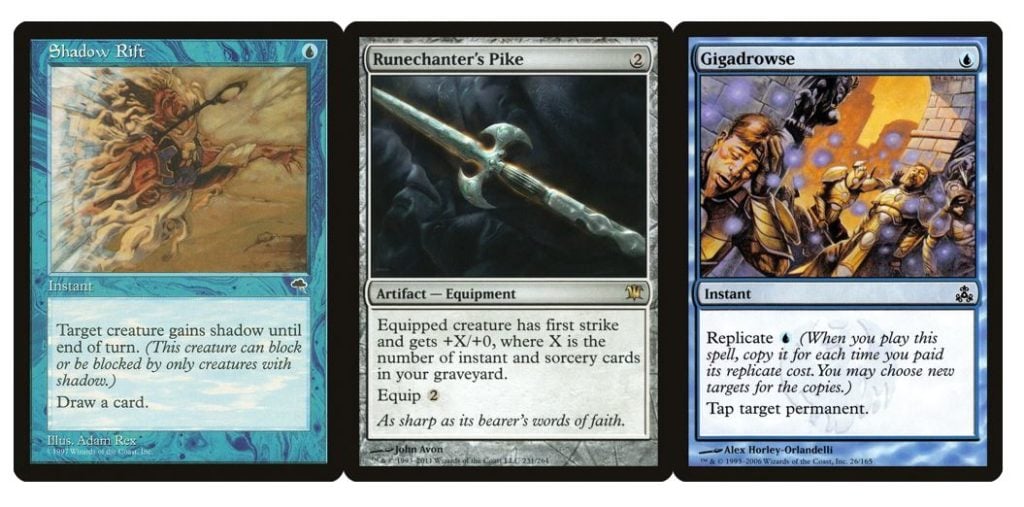
You have a choice of traditional and unconventional win conditions available to you, giving you multiple paths to victory. A number of cantrips grant evasion, such as Shadow Rift, Leap, and Slip Through Space; they can be used in conjunction with Octavia to pierce defenses and maintain pressure, even on the busiest battlefields. You also have access to some classic backup plans in the form of Runechanter’s Pike and Rise From the Tides, which are especially useful if Octavia’s ability is unavailable for any reason. Finally, the most unique win condition comes in the form of Gigadrowse. As Octavia’s “octification” ability triggers whenever you cast or copy a spell, you can pump a creature every time you replicate; this ability, coupled with Gigadrowse’s ability to tap down creatures, means it’s effectively a Craterhoof Behemoth in your mono-blue deck!
Check out the full decklist here!
Spellslinger decks, while powerful and popular, can occasionally feel old hat. Octavia, Living Thesis is proof that this needn’t be the case; a mono-blue spell-based deck that isn’t overloaded with counterspells is not only extremely rare, but also more enjoyable for the table as a whole. Your opponents will be pleasantly surprised by her unique spin on the archetype, and you’ll enjoy casting spells with reckless abandon. If you’re looking for a fresh take on a tried and true strategy, Octavia can lend you a helping hand (or eight)!
Esior, Wardwing Familiar / Ardenn, Intrepid Archaeologist – Equipment
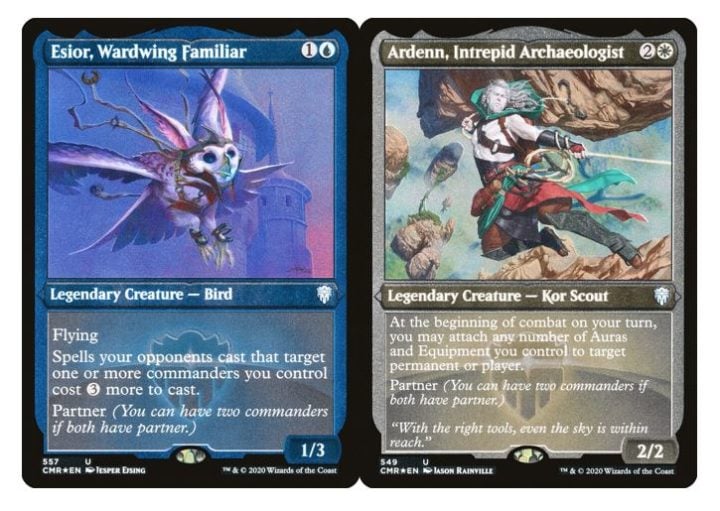
When you think of Azorius in Commander, what’s the first thing that comes to mind? Whether your answer is blink, flyers, stax, or something else entirely, it’s almost certainly not going to be Equipment. According to EDHREC, there are a measly 161 Azorius Equipment decks registered; for context, there are over 3,000 Boros Equipment decks.
However, Esior, Wardwing Familiar and Ardenn, Intrepid Archaeologist make an incredible team, and deserve more recognition as an exceptional Equipment-based pair. Esior provides protection and evasion in the command zone, while Ardenn gives you utility and cost reduction by effectively removing equip costs. Together, they make for an efficient team that can prove difficult to stop!
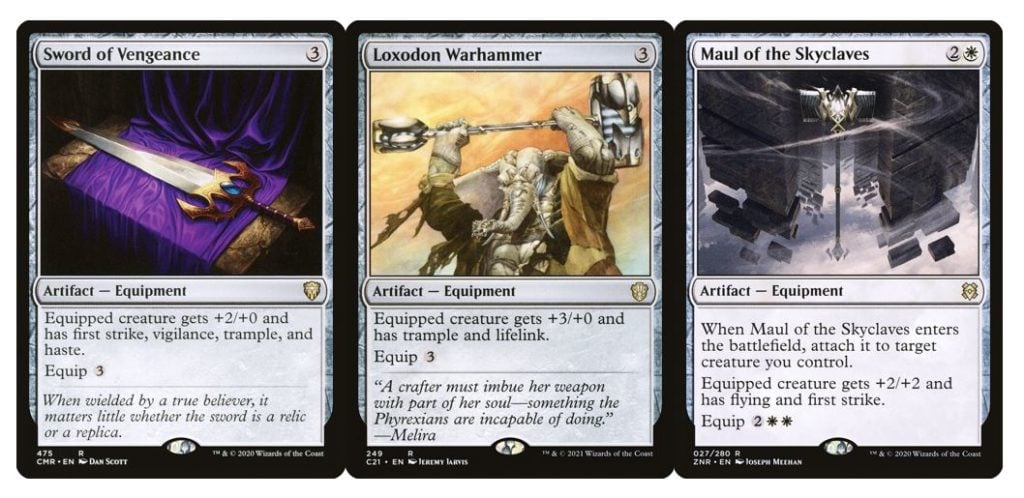
There are countless exceptional pieces of Equipment available to this deck, though many have somewhat unwieldy equip costs. Sword of Vengeance and Loxodon Warhammer are perfect examples; they’re keyword soup that can be equipped, but are usually too costly to attach. Ardenn makes light work of this, essentially giving you free Equipment activations every turn. Sword of Vengeance is particularly nice, as Ardenn can equip it to a summoning sick creature at the beginning of combat and allow them to attack immediately! More recent equipment like Maul of the Skyclaves automatically equips itself to a creature, which helps to take away the sting of equip costs when Ardenn isn’t available.
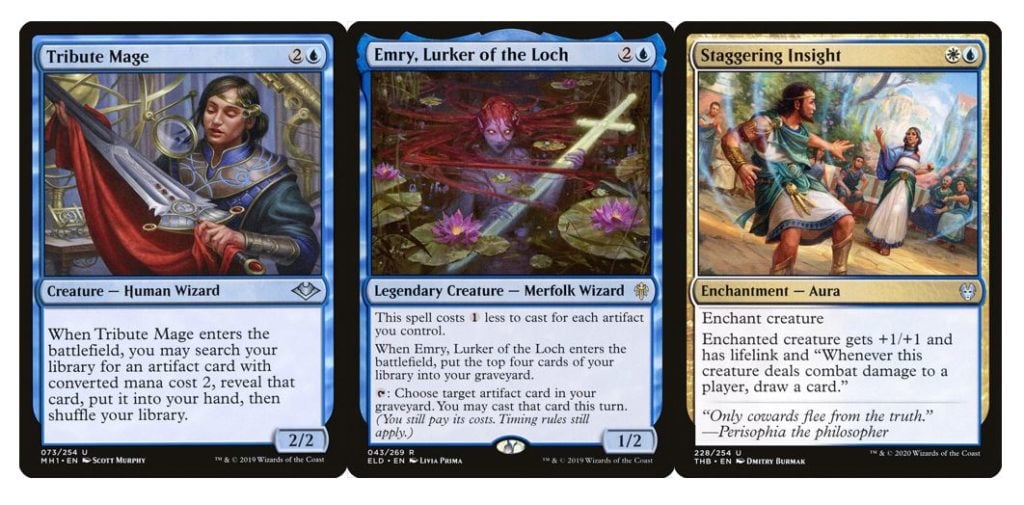
There are a number of benefits that blue brings to the table in an Equipment build, thanks mostly to its extensive suite of artifact related cards. Trinket Mage, Tribute Mage, and Trophy Mage are three powerful artifact tutors that can also hold Equipment well; between the three of them, you can tutor almost any artifact in the deck. Emry, Lurker of the Loch is a fantastic recursion engine that can salvage any removed artifacts and incrementally increase value over time. You can also give her vigilance with your Equipment, to let her attack before using her ability.
Another huge benefit to blue is card draw. Auras like Staggering Insight and Curiosity are incredibly potent, as they reward you just for executing your game plan: attacking! Repeatable card draw lets you recover quickly from board wipes, and powerful value creatures like Thought Monitor ensure you never lose steam. All of these factors add up to one of the most resilient and resourceful Equipment decks possible.
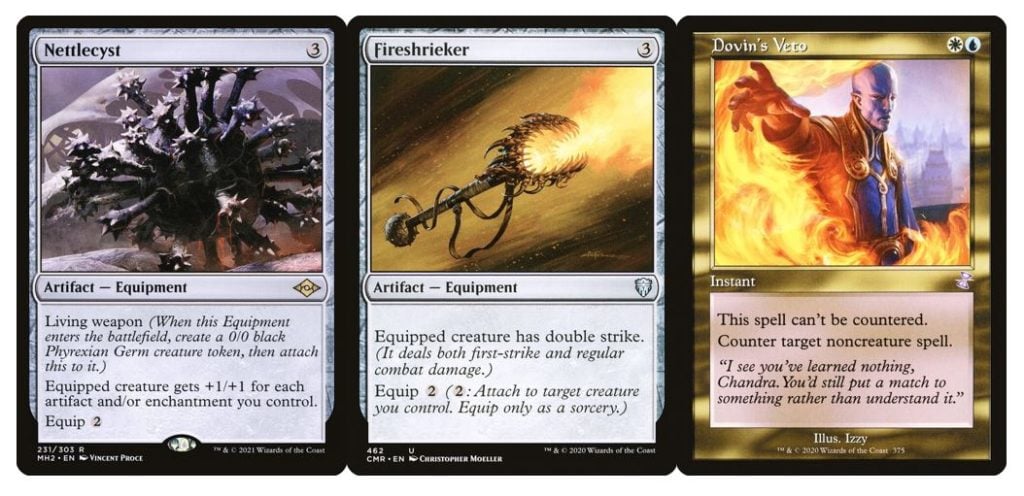
As you’re looking to win through combat damage, Equipment like Nettlecyst and Fireshrieker are automatic inclusions. Commander damage is the most common way to eliminate opponents, but regular creature beatdowns can often get you across the line, too. While Azorius doesn’t have access to explosive cards like Kediss, Emberclaw Familiar, it has more than enough interaction to ensure you maintain a commanding presence. Thanks to Esior’s pseudo-ward ability, you don’t need to run as much protection as you normally would. This frees up some slots to give you access to another benefit from blue: counterspells! They can still be used as protection, but they also function as ways to prevent your opponents from pulling any tricks, like flashing in blockers or sweeping the board. Dovin’s Veto is among the best choices for the deck, preventing you from losing to counter wars.
Check out the full decklist here!
There’s an immense satisfaction to attacking with a creature that has more swords than they can feasibly carry, and Esior & Ardenn still provide this great experience. It may lack the explosiveness that’s synonymous with Boros decks, but it makes up for it by being more interactive and resilient. It can play closer to a tempo deck than a typical Voltron strategy; if you enjoy applying pressure with a powerful value train while controlling the board, look no further than this beefy historian and his evasive avian friend!
***
These are just three decks out of hundreds, if not thousands, that take a unique approach to Commander. Adopting a strategy that isn’t immediately obvious in certain colors can be incredibly rewarding, and is something I highly recommend to any invested Commander player at least once.
I hope these decks gave you some inspiration to develop unique ideas of your own, or even to scroll through EDHREC for ideas and supporting cards. If you have any unique deck ideas like these, or would like to show off your interesting decks, let me know on Twitter. I love to see the creativity that goes into every deck, and I can’t wait to see what you’ve built!

Scott is an Irish content creator and the Head of Budget Magic for the Izzet League. He focuses on affordable decks in Pioneer, Modern, and Pauper, particularly ones that stray from the mainstream. When he’s not writing about his favorite decks, he can be found talking incessantly about them on Twitter and on The Budget Magic Cast.

